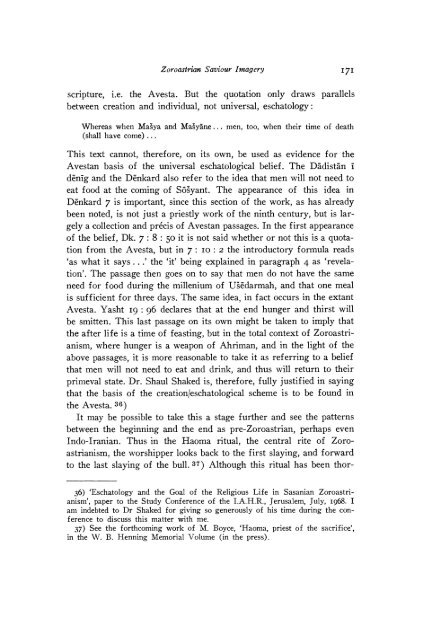Zoroastrian Saviour Imagery and Its Influence on ... - Kaveh Farrokh
Zoroastrian Saviour Imagery and Its Influence on ... - Kaveh Farrokh
Zoroastrian Saviour Imagery and Its Influence on ... - Kaveh Farrokh
Create successful ePaper yourself
Turn your PDF publications into a flip-book with our unique Google optimized e-Paper software.
<str<strong>on</strong>g>Zoroastrian</str<strong>on</strong>g> <str<strong>on</strong>g>Saviour</str<strong>on</strong>g> <str<strong>on</strong>g>Imagery</str<strong>on</strong>g><br />
scripture, i.e. the Avesta. But the quotati<strong>on</strong> <strong>on</strong>ly draws parallels<br />
between creati<strong>on</strong> <str<strong>on</strong>g>and</str<strong>on</strong>g> individual, not universal, eschatology:<br />
Whereas when Masya <str<strong>on</strong>g>and</str<strong>on</strong>g> Masyaye... men, too, when their time of death<br />
(shall have come)...<br />
This text cannot, therefore, <strong>on</strong> its own, be used as evidence for the<br />
Avestan basis of the universal eschatological belief. The Dadistan i<br />
denig <str<strong>on</strong>g>and</str<strong>on</strong>g> the Denkard also refer to the idea that men will not need to<br />
eat food at the coming of Sosyant. The appearance of this idea in<br />
Denkard 7 is important, since this secti<strong>on</strong> of the work, as has already<br />
been noted, is not just a priestly work of the ninth century, but is lar-<br />
gely a collecti<strong>on</strong> <str<strong>on</strong>g>and</str<strong>on</strong>g> precis of Avestan passages. In the first appearance<br />
of the belief, Dk. 7: 8: 50 it is not said whether or not this is a quotati<strong>on</strong><br />
from the Avesta, but in 7: Io: 2 the introductory formula reads<br />
'as what it says...' the 'it' being explained in paragraph 4 as 'revelati<strong>on</strong>'.<br />
The passage then goes <strong>on</strong> to say that men do not have the same<br />
need for food during the millenium of Usedarmah, <str<strong>on</strong>g>and</str<strong>on</strong>g> that <strong>on</strong>e meal<br />
is sufficient for three days. The same idea, in fact occurs in the extant<br />
Avesta. Yasht I9: 96 declares that at the end hunger <str<strong>on</strong>g>and</str<strong>on</strong>g> thirst will<br />
be smitten. This last passage <strong>on</strong> its own might be taken to imply that<br />
the after life is a time of feasting, but in the total c<strong>on</strong>text of <str<strong>on</strong>g>Zoroastrian</str<strong>on</strong>g>ism,<br />
where hunger is a weap<strong>on</strong> of Ahriman, <str<strong>on</strong>g>and</str<strong>on</strong>g> in the light of the<br />
above passages, it is more reas<strong>on</strong>able to take it as referring to a belief<br />
that men will not need to eat <str<strong>on</strong>g>and</str<strong>on</strong>g> drink, <str<strong>on</strong>g>and</str<strong>on</strong>g> thus will return to their<br />
primeval state. Dr. Shaul Shaked is, therefore, fully justified in saying<br />
that the basis of the creati<strong>on</strong>/eschatological scheme is to be found in<br />
the Avesta. 36)<br />
It may be possible to take this a stage further <str<strong>on</strong>g>and</str<strong>on</strong>g> see the patterns<br />
between the beginning <str<strong>on</strong>g>and</str<strong>on</strong>g> the end as pre-<str<strong>on</strong>g>Zoroastrian</str<strong>on</strong>g>, perhaps even<br />
Indo-Iranian. Thus in the Haoma ritual, the central rite of Zoro-<br />
astrianism, the worshipper looks back to the first slaying, <str<strong>on</strong>g>and</str<strong>on</strong>g> forward<br />
to the last slaying of the bull. 37) Although this ritual has been thor-<br />
36) 'Eschatology <str<strong>on</strong>g>and</str<strong>on</strong>g> the Goal of the Religious Life in Sasanian Zoroastri-<br />
anism', paper to the Study C<strong>on</strong>ference of the I.A.H.R., Jerusalem, July, I968. I<br />
am indebted to Dr Shaked for giving so generously of his time during the c<strong>on</strong>-<br />
ference to discuss this matter with me.<br />
37) See the forthcoming work of M. Boyce, 'Haoma, priest of the sacrifice',<br />
in the W. B. Henning Memorial Volume (in the press).<br />
I7I
















